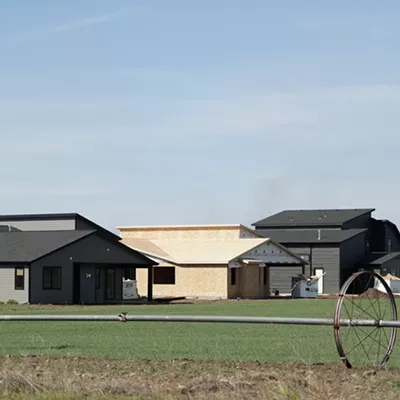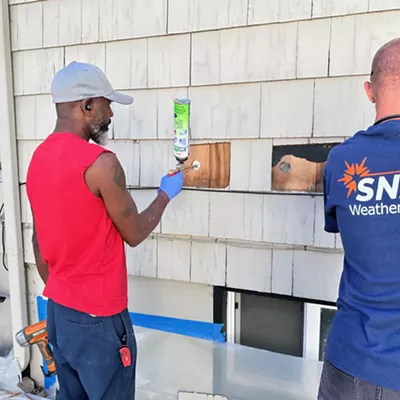Like many artists who create plates and objects out of porcelain, Charles Krafft thinks that his work would look best in group arrangements. In much the same way that china collectors display their trove of fragile figurines in cabinets and line their walls with hand-painted platters, Krafft likes to keep his pieces together. For example, there are the cushioned boxes that hold Krafft's exquisite porcelain switchblades and pistols. A polished wooden case with a glass front presents a row of ceramic grenades, their nubbly military surfaces covered with delicate blue line tracings of flowers and leaves. Below them, suspended gently from wooden hangers, are AK-47 rifles with the words "Villa Delirium" painted in scrollwork on the butt of one. A handy drawer at the bottom of the cabinet keeps a decorated mortar away from dust and clumsy fingers.
"I've imagined these weapons being used in a variety of scenarios," Krafft says, when asked how he most enjoys seeing his work. "It makes the violence implied absurd. I first wanted to build an arsenal that looked like a room of Ming china."
Krafft's line of porcelain weapons, which he calls the Porcelain War Museum Project, has garnered him raves in sources as diverse and notable as the Associated Press, Wired magazine, and The New Yorker. Krafft has taken hand grenades, AK-47s, pistols, machine gun rounds, biological warfare canister grenades, and other objects from contemporary arsenals, and cast non-functional replicas in porcelain. The designs that he hand-paints onto them range from traditional expanses of blue flowers to rural scenes with gentlemen on horseback and gardeners tending shrubs - the sorts of things you'd expect to find on plates in an old-European kitchen or your grandmother's china cupboard. The effect is jarring. In Postmodern Ceramics, Mark Del Vecchio noted that "Krafft is one of the USA's most seditious artists, and plays difficult, uneasy games with content and culture." He will be speaking in Spokane this week as part of the Visiting Artist Lecture Series jointly sponsored by Eastern Washington University, Spokane Falls Community College and the MAC.
"I see myself as an artist who's working with sociological and political symbolism," Krafft explains, talking from his studio in Seattle. "If I didn't say that I knew what I was doing I'd be lying. I don't know how to throw a pot. I couldn't do it for love or money if they put me in front of a potter's wheel. But I know what I'm doing with the images that I use."
What Krafft is doing is creating a sort of cognitive dissonance for the viewer. In much the same way that traditional ceramic artists decorate their pieces with time-tested glazes and familiar patterns, Krafft evokes a familiar world with his painting. But the filigrees and flowers that Krafft works with in the Porcelain War Museum Project are taken off of plates and teacups, and strewn gracefully across another group of familiar shapes: contemporary objects of death. From the machine guns to the grenades, Krafft is using recognizable shapes. We just don't expect them to look so beautiful or to be decorated as if they were collectibles.
Krafft began the series - which has been very popular with collectors - in the late 1990s, obtaining weapons from black-market arms dealers to copy in porcelain. But he had already achieved national attention several years earlier, when he first started painting on porcelain.
Those earlier works come from a series Krafft named Disasterware. Composed on plates and other (mostly) functional objects, Krafft's blue lines depict tragedies like the wreck of the Hindenburg, the bombing of Dresden, and the Kobe earthquake.
"A disaster is a sociopolitical or natural catastrophe," he states, when I ask him what qualifies an event to be featured on one of his plates. "Other than that, they don't have any requirements other than needing some sort of iconographic resonance in the culture - like the Titanic or possibly the Hindenburg. I began with fairly recognizable disasters, and then I sort of drifted into sociopolitical statements, and then I went into noir film scenarios. So there's no rhyme or reason to it. But what I wanted to put on a plate is something you wouldn't normally see in blue and white on a plate because, traditionally, those plates are commemorative. And if they don't commemorate a school or church, they have a scene that puts you to sleep - like a cow or a stream. I wanted to replace commemorative plates and pastoral decoration - that antiquated imagery - with something more contemporary and a little bit closer to the way we live our lives in the 20th century. We're bombarded with catastrophic news reports from all over the world now."
Krafft had started his career as a painter, following in the footsteps of what is now known as the Northwest School, which featured the natural surroundings of the Pacific Northwest as a pan-cultural spiritual iconography. But nothing in his experience working in that tradition prepared him for painting on porcelain. In order to learn that skill, Krafft turned to a different group of artists: the China Painters of the Great Northwest.
"I went and took a class in china painting from these little old ladies that live in Seattle," Krafft says of the experience. "I knew I didn't want to get snagged into this world of woolly potters who were worried about chemistry and glaze - stuff that's incidental to what I wanted to say. So I took a hobby class, and these ladies adopted me. And I sat in with them for a winter, and learned china painting."
In class, Krafft stuck with the standard decorations. But on his own, he started portraying disasters. "What I wanted to do was make second-take art, so that you look at the stuff, and your mind and your experience categorizes what your seeing as Delft," Krafft says, referring to the famous blue-and-white style of china. "You've seen enough of it to know what it is. Then if you look closer and take a second look, you're going to see that it's not quite right. I turn it upside down. Not completely - but I put a horrific veneer on it. It's sort of second-take decorative."
After launching Disasterware and The Porcelain War Museum Project, Krafft has continued into other venues - each of them mixing decoration with political and social content. A line of ceramic skateboards replaces the stickers and designs that many kids use for decoration with paintings of Martha Stewart and scenic modern landscapes. As part of another art line - named Spone - Krafft makes commemorative plates, pots, and tiles out of human ashes. (When asked if it bothers him to work with actual cremains, he quickly answers "No." Then after a moment, he adds, "It's creeped people out who have come to assist me.")
Krafft has also created display bottles for a fake perfume called "Forgiveness." Its glass bottle is etched with a swastika, and the false advertising campaign Krafft has constructed for it features Weimar-era women with texts that say "SWEETER THAN THE SHARPENED EDGE OF MERCY" and "THE SCENT OF UNCONDITIONAL SURRENDER."
Needless to say, some people take Krafft's work personally. But he hopes that, instead of taking part of its message at face value, people are able to step back and realize that the unsettling effect comes from the juxtaposition of two different aesthetic worlds. And that it's the power of art - not politics - that's caused them to stop for a moment. "I don't want it to be too uncomfortable," he says, "because we're already too uncomfortable. But I don't want art to be a palliative. And in the end, I want to capture someone's attention just long enough so that people remember that they have seen something by me. When we're bombarded with imagery - especially now, electronically - to be able to grab someone's attention with inanimate object is a skill. I realize people don't have long to waste thinking about art."
Publication date: 10/30/03
















